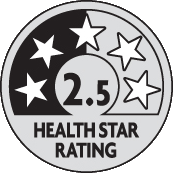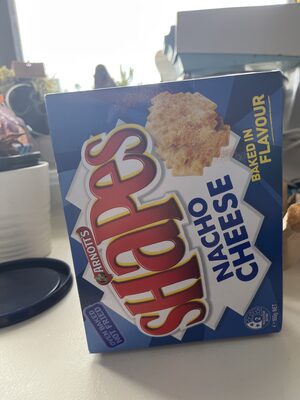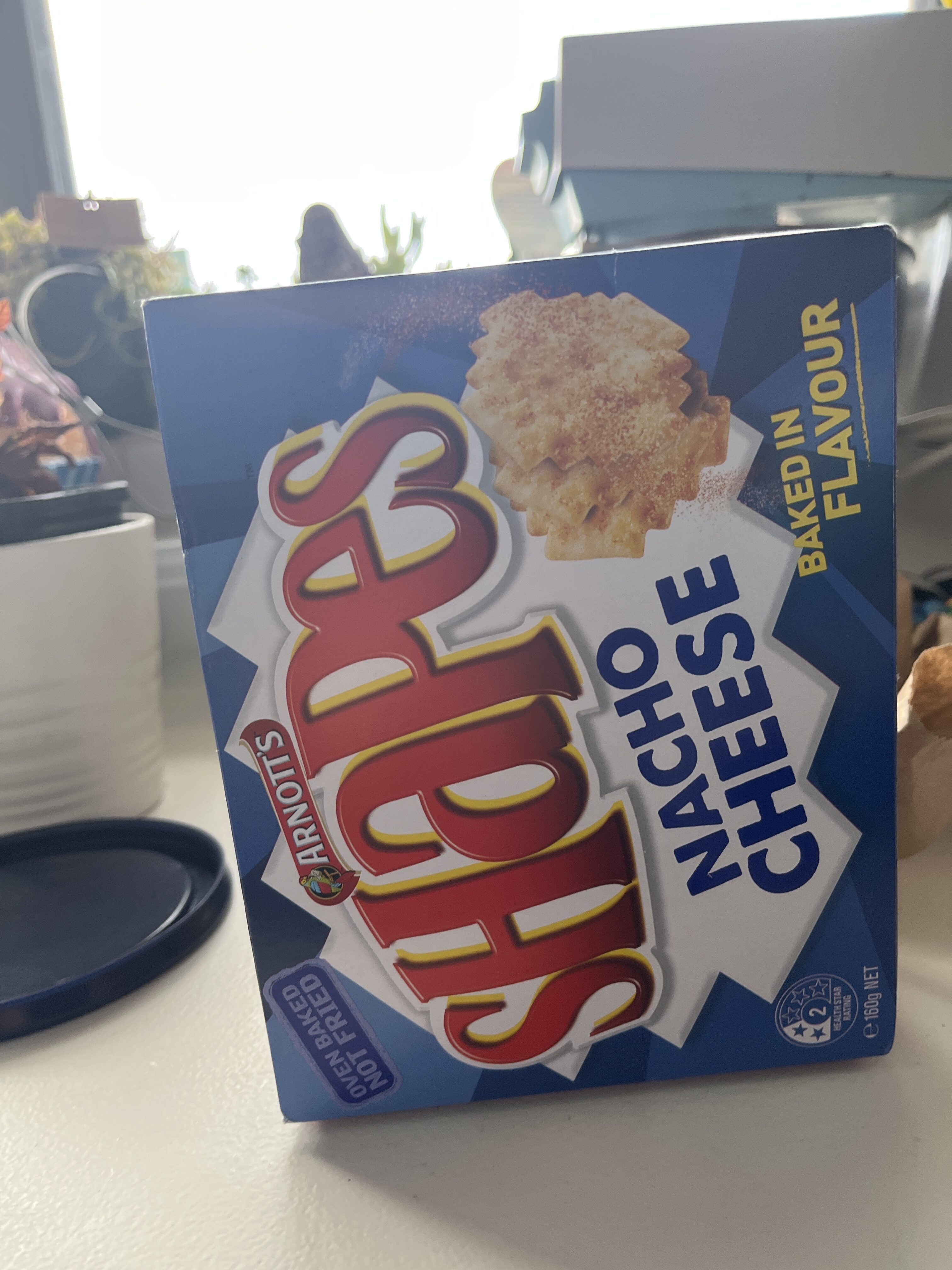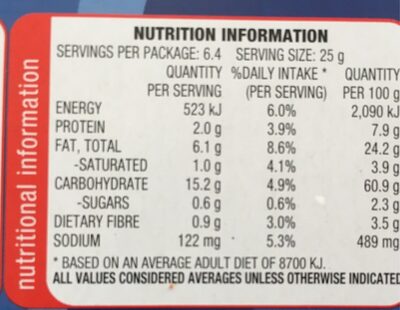Help us make food transparency the norm!
As a non-profit organization, we depend on your donations to continue informing consumers around the world about what they eat.
The food revolution starts with you!
Shapes Nacho Cheese - Arnott's Shapes - 160 g
Shapes Nacho Cheese - Arnott's Shapes - 160 g
This product page is not complete. You can help to complete it by editing it and adding more data from the photos we have, or by taking more photos using the app for Android or iPhone/iPad. Thank you!
×
Barcode: 9310072023205 (EAN / EAN-13)
Quantity: 160 g
Brands: Arnott's Shapes, Arnott's
Categories: Snacks, Salty snacks, Sweet snacks, Appetizers, Biscuits and cakes, Biscuits, Crackers
Labels, certifications, awards:
Australian made, Health Star Rating, Health Star Rating 2.5
Stores: Woolworths, Coles
Countries where sold: Australia
Matching with your preferences
Health
Ingredients
-
45 ingredients
FARINE DE BLÉ, HUILE VÉGÉTALE, LÉGUMES (TOMATE EN POUDRE, OIGNON EN POUDRE, AIL EN POUDRE), FROMAGE (CONTIENT DU LAIT), FÉCULE (MAÏS), SEL, MATIÈRE SÈCHE DU LAIT, LEVURE DE BOULANGER, GLUCOSE, ARÔME (CONTIENT DU LAIT). SUCRE, RENFORÇATEURS DE GOÚT (E621, E635), ÉPICE, LEVURE CHIMIQUE, ACIDES ALIMENTAIRES (E262, E330, E327, E270), COLORANTS ALIMENTAIRES (E150A, E162, E141), EXTRAIT DE LEVURE DE BOULANGER, ANTIOXYDANTS (E300, E307B DE SOJA, E304), ÉMULSIFIANT (LÉCITHINE DE SOJA, E322). CONTIENT DES CEREALES CONTENANT DU GLUTEN, DU LAIT ET DU SOJA. PEUT CONTENIR DES TRACES D'EUF, DE CACAHUETE, DE SESAME ET DE FRUIT A COQUE. FABRIQUE EN AUSTRALIE.Allergens: Gluten, Milk, SoybeansTraces: Peanuts
Food processing
-
Ultra processed foods
Elements that indicate the product is in the 4 - Ultra processed food and drink products group:
- Additive: E141 - Copper complexes of chlorophylls and chlorophyllins
- Additive: E150a - Plain caramel
- Additive: E162 - Beetroot red
- Additive: E322 - Lecithins
- Additive: E327 - Calcium lactate
- Additive: E621 - Monosodium glutamate
- Additive: E635 - Disodium 5'-ribonucleotide
- Ingredient: Glucose
Food products are classified into 4 groups according to their degree of processing:
- Unprocessed or minimally processed foods
- Processed culinary ingredients
- Processed foods
- Ultra processed foods
The determination of the group is based on the category of the product and on the ingredients it contains.
Additives
-
E162 - Beetroot red
Betanin: Betanin, or Beetroot Red, is a red glycosidic food dye obtained from beets; its aglycone, obtained by hydrolyzing away the glucose molecule, is betanidin. As a food additive, its E number is E162. The color of betanin depends on pH; between four and five it is bright bluish-red, becoming blue-violet as the pH increases. Once the pH reaches alkaline levels betanin degrades by hydrolysis, resulting in a yellow-brown color. Betanin is a betalain pigment, together with isobetanin, probetanin, and neobetanin. Other pigments contained in beet are indicaxanthin and vulgaxanthins.Source: Wikipedia
-
E262 - Sodium acetates
Sodium acetate: Sodium acetate, CH3COONa, also abbreviated NaOAc, is the sodium salt of acetic acid. This colorless deliquescent salt has a wide range of uses.Source: Wikipedia
-
E270 - Lactic acid
Lactic acid: Lactic acid is an organic compound with the formula CH3CH-OH-COOH. In its solid state, it is white and water-soluble. In its liquid state, it is colorless. It is produced both naturally and synthetically. With a hydroxyl group adjacent to the carboxyl group, lactic acid is classified as an alpha-hydroxy acid -AHA-. In the form of its conjugate base called lactate, it plays a role in several biochemical processes. In solution, it can ionize a proton from the carboxyl group, producing the lactate ion CH3CH-OH-CO−2. Compared to acetic acid, its pKa is 1 unit less, meaning lactic acid deprotonates ten times more easily than acetic acid does. This higher acidity is the consequence of the intramolecular hydrogen bonding between the α-hydroxyl and the carboxylate group. Lactic acid is chiral, consisting of two optical isomers. One is known as L--+--lactic acid or -S--lactic acid and the other, its mirror image, is D--−--lactic acid or -R--lactic acid. A mixture of the two in equal amounts is called DL-lactic acid, or racemic lactic acid. Lactic acid is hygroscopic. DL-lactic acid is miscible with water and with ethanol above its melting point which is around 17 or 18 °C. D-lactic acid and L-lactic acid have a higher melting point. In animals, L-lactate is constantly produced from pyruvate via the enzyme lactate dehydrogenase -LDH- in a process of fermentation during normal metabolism and exercise. It does not increase in concentration until the rate of lactate production exceeds the rate of lactate removal, which is governed by a number of factors, including monocarboxylate transporters, concentration and isoform of LDH, and oxidative capacity of tissues. The concentration of blood lactate is usually 1–2 mM at rest, but can rise to over 20 mM during intense exertion and as high as 25 mM afterward. In addition to other biological roles, L-lactic acid is the primary endogenous agonist of hydroxycarboxylic acid receptor 1 -HCA1-, which is a Gi/o-coupled G protein-coupled receptor -GPCR-.In industry, lactic acid fermentation is performed by lactic acid bacteria, which convert simple carbohydrates such as glucose, sucrose, or galactose to lactic acid. These bacteria can also grow in the mouth; the acid they produce is responsible for the tooth decay known as caries. In medicine, lactate is one of the main components of lactated Ringer's solution and Hartmann's solution. These intravenous fluids consist of sodium and potassium cations along with lactate and chloride anions in solution with distilled water, generally in concentrations isotonic with human blood. It is most commonly used for fluid resuscitation after blood loss due to trauma, surgery, or burns.Source: Wikipedia
-
E304 - Fatty acid esters of ascorbic acid
Ascorbyl palmitate: Ascorbyl palmitate is an ester formed from ascorbic acid and palmitic acid creating a fat-soluble form of vitamin C. In addition to its use as a source of vitamin C, it is also used as an antioxidant food additive -E number E304-. It is approved for use as a food additive in the EU, the U.S., Canada, Australia, and New Zealand.Ascorbyl palmitate is known to be broken down -through the digestive process- into ascorbic acid and palmitic acid -a saturated fatty acid- before being absorbed into the bloodstream. Ascorbyl palmitate is also marketed as "vitamin C ester".Source: Wikipedia
-
E307b - Concentrated tocopherol
Alpha-Tocopherol: α-Tocopherol is a type of vitamin E. It has E number "E307". Vitamin E exists in eight different forms, four tocopherols and four tocotrienols. All feature a chromane ring, with a hydroxyl group that can donate a hydrogen atom to reduce free radicals and a hydrophobic side chain which allows for penetration into biological membranes. Compared to the others, α-tocopherol is preferentially absorbed and accumulated in humans.Source: Wikipedia
-
E322 - Lecithins
Lecithins are natural compounds commonly used in the food industry as emulsifiers and stabilizers.
Extracted from sources like soybeans and eggs, lecithins consist of phospholipids that enhance the mixing of oil and water, ensuring smooth textures in various products like chocolates, dressings, and baked goods.
They do not present any known health risks.
-
E327 - Calcium lactate
Calcium lactate: Calcium lactate is a white crystalline salt with formula C6H10CaO6, consisting of two lactate anions H3C-CHOH-CO−2 for each calcium cation Ca2+. It forms several hydrates, the most common being the pentahydrate C6H10CaO6·5H2O. Calcium lactate is used in medicine, mainly to treat calcium deficiencies; and as a food additive with E number of E327. Some cheese crystals consist of calcium lactate.Source: Wikipedia
-
E330 - Citric acid
Citric acid is a natural organic acid found in citrus fruits such as lemons, oranges, and limes.
It is widely used in the food industry as a flavor enhancer, acidulant, and preservative due to its tart and refreshing taste.
Citric acid is safe for consumption when used in moderation and is considered a generally recognized as safe (GRAS) food additive by regulatory agencies worldwide.
-
E621 - Monosodium glutamate
Monosodium glutamate: Monosodium glutamate -MSG, also known as sodium glutamate- is the sodium salt of glutamic acid, one of the most abundant naturally occurring non-essential amino acids. Glutamic acid is found naturally in tomatoes, grapes, cheese, mushrooms and other foods.MSG is used in the food industry as a flavor enhancer with an umami taste that intensifies the meaty, savory flavor of food, as naturally occurring glutamate does in foods such as stews and meat soups. It was first prepared in 1908 by Japanese biochemist Kikunae Ikeda, who was trying to isolate and duplicate the savory taste of kombu, an edible seaweed used as a base for many Japanese soups. MSG as a flavor enhancer balances, blends, and rounds the perception of other tastes.The U.S. Food and Drug Administration has given MSG its generally recognized as safe -GRAS- designation. A popular belief is that large doses of MSG can cause headaches and other feelings of discomfort, known as "Chinese restaurant syndrome," but double-blind tests fail to find evidence of such a reaction. The European Union classifies it as a food additive permitted in certain foods and subject to quantitative limits. MSG has the HS code 29224220 and the E number E621.Source: Wikipedia
Ingredients analysis
-
May contain palm oil
Ingredients that may contain palm oil: E304
-
Vegan status unknown
Unrecognized ingredients: Farine-de-ble, Huile-vegetale, Tomate-en-poudre, Oignon-en-poudre, Ail-en-poudre, Fromage, Contient-du-lait, Fecule, Mais, Sel, Matiere-seche-du-lait, Levure-de-boulanger, Arome, Contient-du-lait, Sucre, Renforcateurs-de-gout, Epice, Levure-chimique, Acides-alimentaires, Colorants-alimentaires, Extrait-de-levure-de-boulanger, Antioxydants, E307b-de-soja, Emulsifiant, Lecithine-de-soja, Contient-des-cereales-contenant-du-gluten, Du-lait-et-du-soja, Peut-contenir-des-traces-d-euf, De-cacahuete, De-sesame-et-de-fruit-a-coque, Fabrique-en-australieSome ingredients could not be recognized.
We need your help!
You can help us recognize more ingredients and better analyze the list of ingredients for this product and others:
- Edit this product page to correct spelling mistakes in the ingredients list, and/or to remove ingredients in other languages and sentences that are not related to the ingredients.
- Add new entries, synonyms or translations to our multilingual lists of ingredients, ingredient processing methods, and labels.
If you would like to help, join the #ingredients channel on our Slack discussion space and/or learn about ingredients analysis on our wiki. Thank you!
-
Vegetarian status unknown
Unrecognized ingredients: Farine-de-ble, Huile-vegetale, Tomate-en-poudre, Oignon-en-poudre, Ail-en-poudre, Fromage, Contient-du-lait, Fecule, Mais, Sel, Matiere-seche-du-lait, Levure-de-boulanger, Arome, Contient-du-lait, Sucre, Renforcateurs-de-gout, Epice, Levure-chimique, Acides-alimentaires, Colorants-alimentaires, Extrait-de-levure-de-boulanger, Antioxydants, E307b-de-soja, Emulsifiant, Lecithine-de-soja, Contient-des-cereales-contenant-du-gluten, Du-lait-et-du-soja, Peut-contenir-des-traces-d-euf, De-cacahuete, De-sesame-et-de-fruit-a-coque, Fabrique-en-australieSome ingredients could not be recognized.
We need your help!
You can help us recognize more ingredients and better analyze the list of ingredients for this product and others:
- Edit this product page to correct spelling mistakes in the ingredients list, and/or to remove ingredients in other languages and sentences that are not related to the ingredients.
- Add new entries, synonyms or translations to our multilingual lists of ingredients, ingredient processing methods, and labels.
If you would like to help, join the #ingredients channel on our Slack discussion space and/or learn about ingredients analysis on our wiki. Thank you!
-
Details of the analysis of the ingredients
We need your help!
Some ingredients could not be recognized.
We need your help!
You can help us recognize more ingredients and better analyze the list of ingredients for this product and others:
- Edit this product page to correct spelling mistakes in the ingredients list, and/or to remove ingredients in other languages and sentences that are not related to the ingredients.
- Add new entries, synonyms or translations to our multilingual lists of ingredients, ingredient processing methods, and labels.
If you would like to help, join the #ingredients channel on our Slack discussion space and/or learn about ingredients analysis on our wiki. Thank you!
: FARINE DE BLÉ, HUILE VÉGÉTALE, LÉGUMES (TOMATE EN POUDRE, OIGNON EN POUDRE, AIL EN POUDRE), FROMAGE (CONTIENT DU LAIT), FÉCULE (MAÏS), SEL, MATIÈRE SÈCHE DU LAIT, LEVURE DE BOULANGER, GLUCOSE, ARÔME (CONTIENT DU LAIT), SUCRE, RENFORÇATEURS DE GOÚT (e621, e635), ÉPICE, LEVURE CHIMIQUE, ACIDES ALIMENTAIRES (e262, e330, e327, e270), COLORANTS ALIMENTAIRES (e150A, e162, e141), EXTRAIT DE LEVURE DE BOULANGER, ANTIOXYDANTS (e300, e307B DE SOJA, e304), ÉMULSIFIANT (LÉCITHINE DE SOJA, e322), CONTIENT DES CEREALES CONTENANT DU GLUTEN, DU LAIT ET DU SOJA, PEUT CONTENIR DES TRACES D'EUF, DE CACAHUETE, DE SESAME ET DE FRUIT A COQUE, FABRIQUE EN AUSTRALIE- FARINE DE BLÉ -> en:farine-de-ble - percent_min: 4 - percent_max: 100
- HUILE VÉGÉTALE -> en:huile-vegetale - percent_min: 0 - percent_max: 50
- LÉGUMES -> en:legume - vegan: yes - vegetarian: yes - percent_min: 0 - percent_max: 33.3333333333333
- TOMATE EN POUDRE -> en:tomate-en-poudre - percent_min: 0 - percent_max: 33.3333333333333
- OIGNON EN POUDRE -> en:oignon-en-poudre - percent_min: 0 - percent_max: 16.6666666666667
- AIL EN POUDRE -> en:ail-en-poudre - percent_min: 0 - percent_max: 11.1111111111111
- FROMAGE -> en:fromage - percent_min: 0 - percent_max: 25
- CONTIENT DU LAIT -> en:contient-du-lait - percent_min: 0 - percent_max: 25
- FÉCULE -> en:fecule - percent_min: 0 - percent_max: 20
- MAÏS -> en:mais - percent_min: 0 - percent_max: 20
- SEL -> en:sel - percent_min: 0 - percent_max: 16.6666666666667
- MATIÈRE SÈCHE DU LAIT -> en:matiere-seche-du-lait - percent_min: 0 - percent_max: 14.2857142857143
- LEVURE DE BOULANGER -> en:levure-de-boulanger - percent_min: 0 - percent_max: 12.5
- GLUCOSE -> en:glucose - vegan: yes - vegetarian: yes - ciqual_proxy_food_code: 31016 - percent_min: 0 - percent_max: 11.1111111111111
- ARÔME -> en:arome - percent_min: 0 - percent_max: 10
- CONTIENT DU LAIT -> en:contient-du-lait - percent_min: 0 - percent_max: 10
- SUCRE -> en:sucre - percent_min: 0 - percent_max: 9.09090909090909
- RENFORÇATEURS DE GOÚT -> en:renforcateurs-de-gout - percent_min: 0 - percent_max: 8.33333333333333
- e621 -> en:e621 - vegan: yes - vegetarian: yes - percent_min: 0 - percent_max: 8.33333333333333
- e635 -> en:e635 - vegan: maybe - vegetarian: maybe - percent_min: 0 - percent_max: 4.16666666666667
- ÉPICE -> en:epice - percent_min: 0 - percent_max: 7.69230769230769
- LEVURE CHIMIQUE -> en:levure-chimique - percent_min: 0 - percent_max: 7.14285714285714
- ACIDES ALIMENTAIRES -> en:acides-alimentaires - percent_min: 0 - percent_max: 6.66666666666667
- e262 -> en:e262 - vegan: yes - vegetarian: yes - percent_min: 0 - percent_max: 6.66666666666667
- e330 -> en:e330 - vegan: yes - vegetarian: yes - percent_min: 0 - percent_max: 3.33333333333333
- e327 -> en:e327 - vegan: yes - vegetarian: yes - percent_min: 0 - percent_max: 2.22222222222222
- e270 -> en:e270 - vegan: yes - vegetarian: yes - percent_min: 0 - percent_max: 1.66666666666667
- COLORANTS ALIMENTAIRES -> en:colorants-alimentaires - percent_min: 0 - percent_max: 6.25
- e150A -> en:e150a - vegan: yes - vegetarian: yes - percent_min: 0 - percent_max: 6.25
- e162 -> en:e162 - vegan: yes - vegetarian: yes - percent_min: 0 - percent_max: 3.125
- e141 -> en:e141 - vegan: yes - vegetarian: yes - percent_min: 0 - percent_max: 2.08333333333333
- EXTRAIT DE LEVURE DE BOULANGER -> en:extrait-de-levure-de-boulanger - percent_min: 0 - percent_max: 5.88235294117647
- ANTIOXYDANTS -> en:antioxydants - percent_min: 0 - percent_max: 5.55555555555556
- e300 -> en:e300 - vegan: yes - vegetarian: yes - percent_min: 0 - percent_max: 5.55555555555556
- e307B DE SOJA -> en:e307b-de-soja - percent_min: 0 - percent_max: 2.77777777777778
- e304 -> en:e304 - vegan: maybe - vegetarian: maybe - from_palm_oil: maybe - percent_min: 0 - percent_max: 1.85185185185185
- ÉMULSIFIANT -> en:emulsifiant - percent_min: 0 - percent_max: 5.26315789473684
- LÉCITHINE DE SOJA -> en:lecithine-de-soja - percent_min: 0 - percent_max: 5.26315789473684
- e322 -> en:e322 - vegan: maybe - vegetarian: maybe - percent_min: 0 - percent_max: 2.63157894736842
- CONTIENT DES CEREALES CONTENANT DU GLUTEN -> en:contient-des-cereales-contenant-du-gluten - percent_min: 0 - percent_max: 5
- DU LAIT ET DU SOJA -> en:du-lait-et-du-soja - percent_min: 0 - percent_max: 4.76190476190476
- PEUT CONTENIR DES TRACES D'EUF -> en:peut-contenir-des-traces-d-euf - percent_min: 0 - percent_max: 4.54545454545455
- DE CACAHUETE -> en:de-cacahuete - percent_min: 0 - percent_max: 4.34782608695652
- DE SESAME ET DE FRUIT A COQUE -> en:de-sesame-et-de-fruit-a-coque - percent_min: 0 - percent_max: 4.16666666666667
- FABRIQUE EN AUSTRALIE -> en:fabrique-en-australie - percent_min: 0 - percent_max: 4
Nutrition
-
Poor nutritional quality
⚠ ️Warning: the amount of fiber is not specified, their possible positive contribution to the grade could not be taken into account.⚠ ️Warning: the amount of fruits, vegetables and nuts is not specified on the label, it was estimated from the list of ingredients: 12This product is not considered a beverage for the calculation of the Nutri-Score.
Positive points: 0
- Proteins: 4 / 5 (value: 7.9, rounded value: 7.9)
- Fiber: 0 / 5 (value: 0, rounded value: 0)
- Fruits, vegetables, nuts, and colza/walnut/olive oils: 0 / 5 (value: 12, rounded value: 12)
Negative points: 14
- Energy: 6 / 10 (value: 2188, rounded value: 2188)
- Sugars: 0 / 10 (value: 2.3, rounded value: 2.3)
- Saturated fat: 3 / 10 (value: 3.9, rounded value: 3.9)
- Sodium: 5 / 10 (value: 489, rounded value: 489)
The points for proteins are not counted because the negative points are greater or equal to 11.
Nutritional score: (14 - 0)
Nutri-Score:
-
Nutrient levels
-
Fat in high quantity (24.2%)
What you need to know- A high consumption of fat, especially saturated fats, can raise cholesterol, which increases the risk of heart diseases.
Recommendation: Limit the consumption of fat and saturated fat- Choose products with lower fat and saturated fat content.
-
Saturated fat in moderate quantity (3.9%)
What you need to know- A high consumption of fat, especially saturated fats, can raise cholesterol, which increases the risk of heart diseases.
Recommendation: Limit the consumption of fat and saturated fat- Choose products with lower fat and saturated fat content.
-
Sugars in low quantity (2.3%)
What you need to know- A high consumption of sugar can cause weight gain and tooth decay. It also augments the risk of type 2 diabetes and cardio-vascular diseases.
Recommendation: Limit the consumption of sugar and sugary drinks- Sugary drinks (such as sodas, fruit beverages, and fruit juices and nectars) should be limited as much as possible (no more than 1 glass a day).
- Choose products with lower sugar content and reduce the consumption of products with added sugars.
-
Salt in moderate quantity (1.22%)
What you need to know- A high consumption of salt (or sodium) can cause raised blood pressure, which can increase the risk of heart disease and stroke.
- Many people who have high blood pressure do not know it, as there are often no symptoms.
- Most people consume too much salt (on average 9 to 12 grams per day), around twice the recommended maximum level of intake.
Recommendation: Limit the consumption of salt and salted food- Reduce the quantity of salt used when cooking, and don't salt again at the table.
- Limit the consumption of salty snacks and choose products with lower salt content.
-
-
Nutrition facts
Nutrition facts As sold
for 100 g / 100 mlCompared to: Crackers Energy 2,188 kj
(523 kcal)+20% Fat 24.2 g +66% Saturated fat 3.9 g +11% Carbohydrates 60.9 g -1% Sugars 2.3 g -36% Fiber ? Proteins 7.9 g -18% Salt 1.222 g -11% Fruits‚ vegetables‚ nuts and rapeseed‚ walnut and olive oils (estimate from ingredients list analysis) 12 %
Environment
-
Eco-Score B - Low environmental impact
⚠ ️The full impact of transportation to your country is currently unknown.The Eco-Score is an experimental score that summarizes the environmental impacts of food products.→ The Eco-Score was initially developped for France and it is being extended to other European countries. The Eco-Score formula is subject to change as it is regularly improved to make it more precise and better suited to each country.Life cycle analysis
-
Average impact of products of the same category: A (Score: 87/100)
Category: Salty snacks, crackers, plain
Category: Salty snacks, crackers, plain
- PEF environmental score: 0.22 (the lower the score, the lower the impact)
- including impact on climate change: 1.59 kg CO2 eq/kg of product
Stage Impact Agriculture
59.7 %Processing
22.4 %Packaging
10.6 %Transportation
5.2 %Distribution
2.2 %Consumption
0.0 %
Bonuses and maluses
-
Missing origins of ingredients information
Malus:
⚠ ️ The origins of the ingredients of this product are not indicated.
If they are indicated on the packaging, you can modify the product sheet and add them.
If you are the manufacturer of this product, you can send us the information with our free platform for producers.
-
Missing packaging information for this product
Malus: -15
⚠ ️ The information about the packaging of this product is not filled in.⚠ ️ For a more precise calculation of the Eco-Score, you can modify the product page and add them.
If you are the manufacturer of this product, you can send us the information with our free platform for producers.
Eco-Score for this product
-
Impact for this product: B (Score: 67/100)
Product: Shapes Nacho Cheese - Arnott's Shapes - 160 g
Life cycle analysis score: 87
Sum of bonuses and maluses: -15
Final score: 67/100
-
Carbon footprint
-
Equal to driving 0.8 km in a petrol car
159 g CO² per 100g of product
The carbon emission figure comes from ADEME's Agribalyse database, for the category: Salty snacks, crackers, plain (Source: ADEME Agribalyse Database)
Stage Impact Agriculture
53.6 %Processing
18.8 %Packaging
17.7 %Transportation
8.7 %Distribution
1.2 %Consumption
0.0 %
Packaging
-
Missing packaging information for this product
⚠ ️ The information about the packaging of this product is not filled in.Take a photo of the recycling information Take a photo of the recycling information
Transportation
-
Origins of ingredients
Missing origins of ingredients information
⚠ ️ The origins of the ingredients of this product are not indicated.
If they are indicated on the packaging, you can modify the product sheet and add them.
If you are the manufacturer of this product, you can send us the information with our free platform for producers.Add the origins of ingredients for this product Add the origins of ingredients for this product
Report a problem
-
Incomplete or incorrect information?
Category, labels, ingredients, allergens, nutritional information, photos etc.
If the information does not match the information on the packaging, please complete or correct it. Open Food Facts is a collaborative database, and every contribution is useful for all.
Data sources
Product added on by rjhunter
Last edit of product page on by roboto-app.
Product page also edited by archanox, clockwerx, kiliweb, marilyn, openfoodfacts-contributors, yuka.UkpFZUZxWXNqY0l1eS9Jc3dSM3l5OU5WNUx1bkFudVhGUE1BSVE9PQ.











